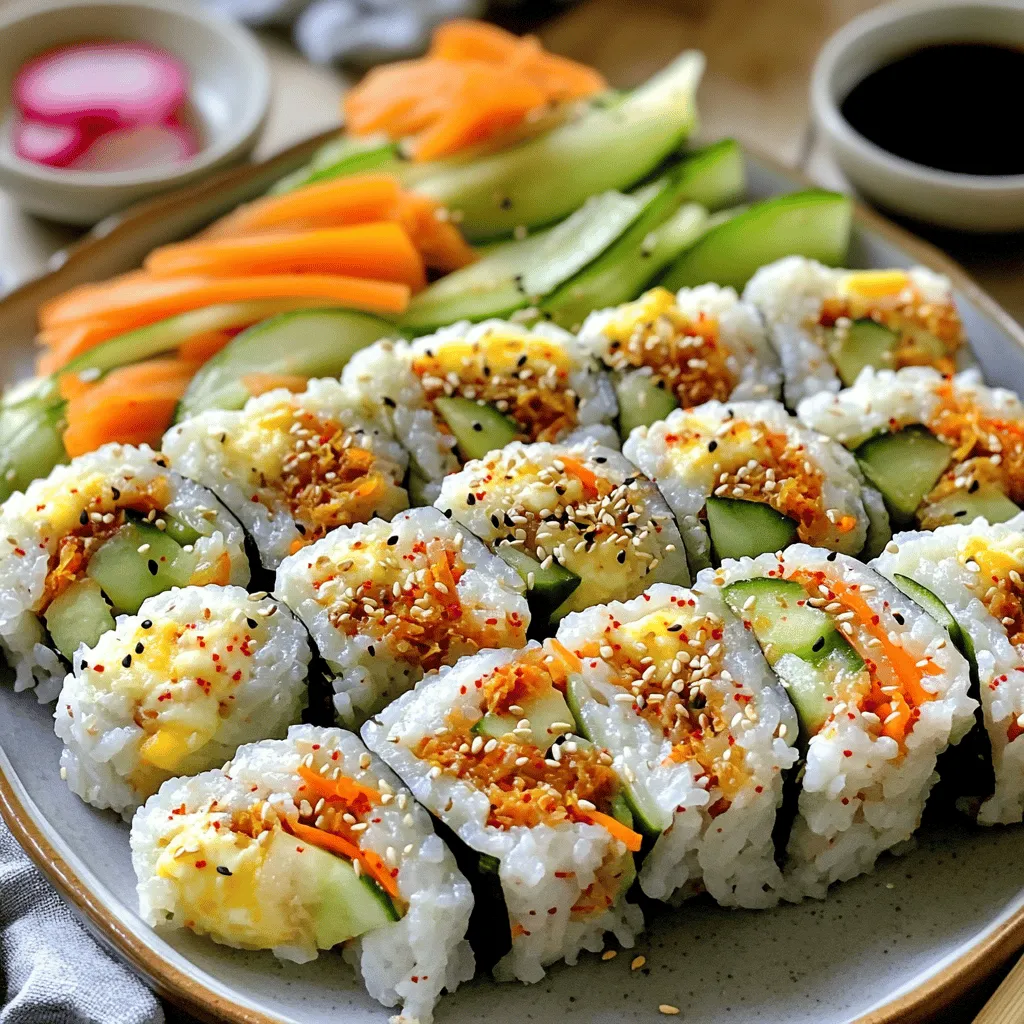Are you ready to try something delicious and fun? Korean Cheese Kimchi Kimbap is a tasty twist on the classic rice roll. With gooey mozzarella, spicy kimchi, and fresh veggies, it’s a snack that bursts with flavor. In this guide, I’ll show you how to make this dish step by step. Let’s dive into the tasty world of Kimbap and impress your friends and family with your cooking skills!
Ingredients
To make Korean cheese kimchi kimbap, you need some key ingredients. Here’s what you’ll need:
– 2 cups cooked short-grain rice
– 1 tablespoon sesame oil
– 1 teaspoon salt
– 4 sheets of nori seaweed
– 1 cup kimchi, well-drained and chopped
– 1 cup mozzarella cheese, shredded
– 1 small cucumber, julienned
– 1 small carrot, julienned
– 2 eggs, beaten
– 2 tablespoons vegetable oil
– Sesame seeds, for garnish
Each item plays a role in making this dish tasty and fun. The cooked rice gives the kimbap its base. Sesame oil adds a nutty taste, while salt enhances all the flavors. Nori wraps everything together, offering a nice texture. Kimchi brings a spicy kick, and mozzarella adds creaminess.
Fresh cucumber and carrot add crunch and color. The eggs, cooked into a thin omelet, provide protein and a soft bite. Sesame seeds on top add a final touch of flavor and crunch.
These ingredients create a blend of tastes and textures.
Step-by-Step Instructions
Preparation of Rice
To start, you need cooked short-grain rice. I love using rice that is sticky. It helps hold the kimbap together. In a large bowl, mix the rice with sesame oil and salt. Use your hands to combine it well. This step flavors the rice and makes it shine.
Making the Omelet
Next, we will make a simple omelet. Beat two eggs in a bowl until mixed. Heat one tablespoon of vegetable oil in a non-stick skillet. Pour in the eggs and swirl the pan. Cook until just set, then flip it over for a minute. After that, take the omelet out and let it cool. Slice it into thin strips.
Assembling the Kimbap
Now for the fun part! Lay a sheet of nori on a bamboo mat, shiny side down. Wet your hands, then grab about a cup of the rice. Spread it evenly on the nori, leaving an inch at the top. Next, place the kimchi, shredded mozzarella cheese, julienned cucumber, julienned carrot, and omelet strips in the center.
Start rolling from the bottom edge, pressing gently but firmly. Don’t squish the filling too much. When you reach the top edge, seal it with a bit of water. Repeat this with the other sheets of nori. Finally, use a sharp knife to slice the rolls into bite-sized pieces. Sprinkle sesame seeds on top for extra crunch.
Tips & Tricks
Best Practices for Rolling Kimbap
To roll kimbap well, start with a bamboo mat. Place the nori on the mat, shiny side down. Use wet hands to spread rice evenly. Leave one inch at the top. This space helps seal the roll. When you add fillings, keep them in the center. Start rolling from the bottom edge. Roll tightly but gently to avoid squishing. Seal the edge with a little water.
Ensuring Perfect Rice Texture
Texture is key for great kimbap. Use short-grain rice for the best stickiness. After cooking, let the rice cool a bit. Mix in sesame oil and salt while it is still warm. This adds flavor and keeps the rice moist. If the rice is too dry, it won’t stick well. If it’s too wet, it will be mushy.
How to Cut Kimbap Neatly
To cut kimbap, use a sharp knife. Wet the knife with water to prevent sticking. Slice through the roll gently, making even cuts. Aim for bite-sized pieces, about an inch thick. If you press too hard, the filling will spill out. Always wipe the knife between cuts for cleaner slices.
Following these tips will help you create a beautiful and tasty Korean Cheese Kimchi Kimbap.

Variations
Recommended Ingredient Substitutions
You can swap some ingredients in kimbap. If you want a lighter taste, use brown rice instead of white. This gives a nutty flavor and more fiber. For a savory twist, try using avocado in place of cheese. It adds creaminess without the dairy. You can also replace sesame oil with olive oil for a different taste.
Alternative Fillings and Add-Ons
Feel free to get creative with your fillings. You can add spinach for a fresh crunch or pickled vegetables for extra tang. Cooked shrimp or crab can bring a seafood twist. You can also use tofu for protein. If you like spice, add a bit of gochujang for a kick.
Making a Vegan Version
To make a vegan kimbap, simply leave out the eggs and cheese. Use marinated tofu or tempeh as a protein source. You can also add more veggies, like bell peppers or zucchini. This way, you still enjoy a tasty and satisfying meal.
Storage Info
Best Storage Practices
To keep your Korean cheese kimchi kimbap fresh, store it in an airtight container. Wrap each roll in plastic wrap to prevent drying. This helps keep the nori crisp and the filling tasty. If you have leftover kimbap, place it in the fridge within two hours of making it.
Reheating Tips
Reheating kimbap can be tricky since you want to avoid sogginess. For best results, unwrap the kimbap and heat it in a pan over low heat. This helps restore some crispness to the nori. If you prefer it warm, microwave for just 10-15 seconds. This warms it without making it mushy.
Shelf Life of Kimbap
Kimbap is best eaten fresh. However, it can last in the fridge for up to three days. After that, the nori may lose its crunchiness. Always check for freshness before eating. If the smell or texture seems off, it’s best to toss it. Enjoy your kimbap within this time for the best taste!
FAQs
What is the origin of Kimbap?
Kimbap comes from Korea. It started as a simple meal for travelers. The dish combines rice and various fillings rolled in seaweed. People made kimbap for picnics or school lunches. Over time, it gained popularity and evolved with new ingredients. Today, you can find many versions, including our cheesy kimchi kimbap.
Can I freeze Kimbap?
Yes, you can freeze kimbap! Wrap each roll tightly in plastic wrap. Then, place them in a freezer bag. This keeps them fresh for a few months. To eat, thaw in the fridge overnight. You can also microwave them for a quick warm-up.
What are common dips or side dishes with Kimbap?
Kimbap pairs well with different dips and sides. Here are some favorites:
– Soy sauce for dipping
– Pickled radish adds crunch
– Kimchi for extra flavor
– Spicy gochujang sauce for heat
These sides enhance the taste of kimbap and make every bite exciting.
How to make Kimbap without cheese?
Making kimbap without cheese is easy! Just skip the mozzarella in the recipe. You can add more veggies or protein instead. Tofu or cooked meat works great as a substitute. Adjust the flavors with extra kimchi or sauces. Your kimbap will still be tasty and satisfying!
Kimbap is a tasty dish that combines simple ingredients like rice and veggies. We explored its essential ingredients, step-by-step instructions, and helpful tips. You learned about variations, storage practices, and answers to common questions. Making kimbap can be fun and easy. Try it out and enjoy your creation. With practice, you can perfect your roll and impress your family and friends. Dive into this delicious adventure!


